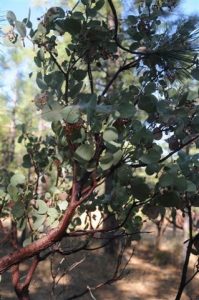Now that autumn is here and our seasonal rains are just around the corner, it is time to dust off your gardening gloves and pull out your shovels – again. Although the majority of us tend to do our planting in spring, October is a good month, in the foothills and lower elevations of the Sierra, for putting California native plants in the garden. The soil is still warm, yet the average air temperature and amount of daylight hours have decreased, creating less stress for new plants. The increased moisture in the air and regular rains help to stimulate root growth, so that root systems are well established before the start of our drought season. This greatly reduces the amount of water you need to help the plants become established.
You could plant California natives through fall, into winter and even early spring. But you would need to consider whether the plant is frost sensitive, whether it would have enough time to establish deep roots before summer and when you will get snowfall, if any, at your elevation. When California natives, as well as other plants, are planted in spring, or even early summer, they need to be pampered and watered often since root systems are not yet at a depth where they can obtain deep soil moisture on their own.
California native plants are well suited to the conditions found in their particular California ecosystem. Typically, these plants exhibit a proliferation of blooms in the spring, go dormant during the summer with a lack of water, only to begin growing again in the fall. As a result, many native plants need minimal amounts of water once they have become established (not true for riparian natives). This is certainly beneficial at a time when we all need to conserve water. Since these plants are adapted to the soil as well as the climate, there is little or no need for fertilizer.
An integral part of their ecosystem, California native plants form important interdependent relationships with the natural animals, fungi and microbes living amongst them. Therefore, planting natives in your garden will enhance wildlife habitats and your ability to view them. When penstemons and salvias are blooming, native pollinators are on hand to collect nectar and transfer pollen. Manzanita bushes provide shelter and food for native birds and insects. Native seeds serve as nutrition for the animals living in the ecosystem. When native plants die, their biomass and moisture are transferred to the soil, benefitting the microbes and fungi found there, which in turn will help other native plants grow and thrive under harsh conditions.
Low-density California native plants with minimal levels of oils & resins can represent a reduction in fire fuel loads when used in landscaping in comparison to non-native ornamentals, particularly when spaced widely apart. Although no plant is fire resistant, recent articles from the California Native Plant Society publication Fremontia, indicate that most native plants take longer to catch fire than non-natives because they are able to retain a high content of water in their leaves during drought conditions and produce little dead material. Ceanothus species were hard to burn and were even more resistant with some occasional summer water.
Are you ready to plant some California natives this fall? Native plants can be purchased at local nurseries as well as at the Fall Plant Sale being held by the Sierra Foothill Chapter of the California Native Plant Society on Saturday, October 13th from 9am to noon at Rocca Park in Jamestown. Be sure to get some advice on which natives are adapted for your elevation and type of ecosystem so that you can reap the benefits of having natives in your garden. Additional information about California native plants can be found at www.cnps.org. You can look to see what type of natives grow at your particular zip code at www.calflora.org.
Kathi Joye is a recent graduate of the Tuolumne County University of California Cooperative Extension Master Gardener training program.





